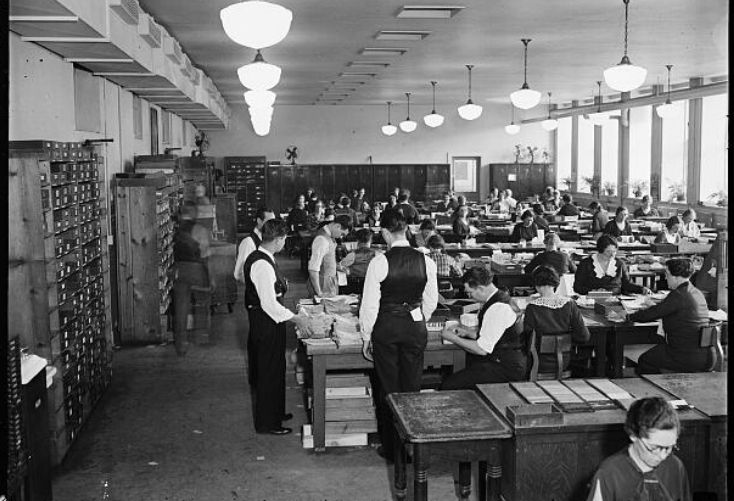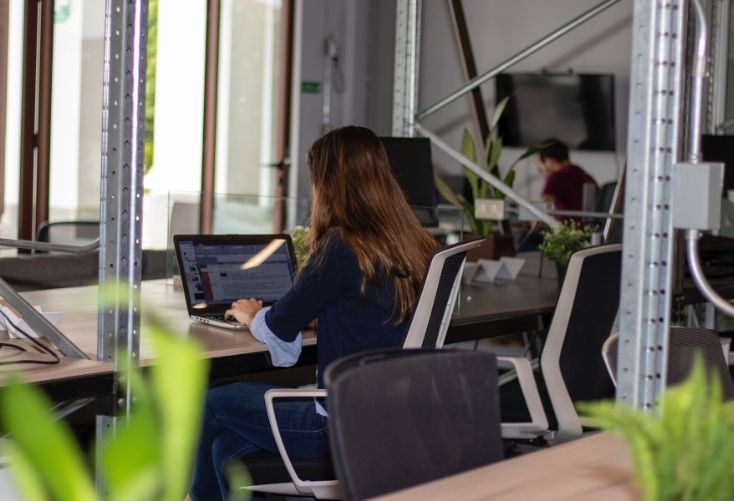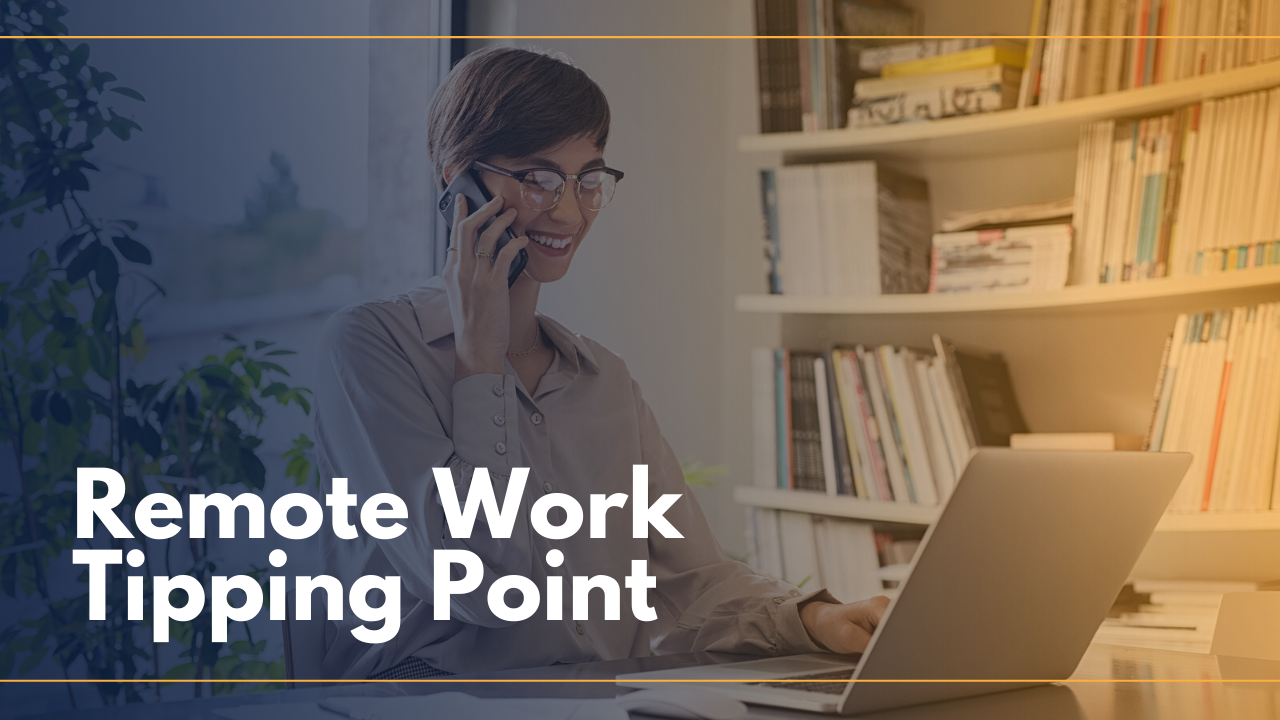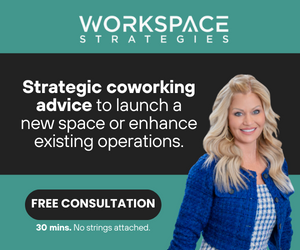- We can learn a lot about the evolving future of work by understanding the changing work dynamics of the past.
- It took 100+ years to introduce an 8-hour workday; remote work was on a similar trajectory until the health crisis erupted in 2020.
- The pandemic has created a remote work tipping point, which will have a permanent impact on the way we use and interact with our places of work.
The pandemic of 2020 immediately changed how and where the entire world worked. This rapid adoption enabled the “Remote Work Tipping Point” which will have long-term impacts on how individuals, organizations, and governments work, hire and utilize workspaces, real estate, and much more.
What happens when people or organizations have a failed remote work experience, a great one, or somewhere in between? How will the future of how and where we work change in the near and long term? Will central offices still be important? There are many questions to consider.
Instead of immediately looking forward to the future, it is important to learn from the changing work dynamics of the past and then apply that to the ever-evolving future of work.
Change Typically Takes Time, Effort, and Incremental Progress
Changes to work and the workplace have typically taken a long time to achieve, with substantial effort and numerous incremental compromises.
For example, the movement for “Labor, Recreation, and Rest” and the 8 hour work day alone took 100+ years of strikes, clashes, backlash, and compromises between workers, unions, police, employers, and governments until finally passed into law in the United States between 1939 – 1940. Over that time period, instead of immediately shifting from 12+ hour workdays to an 8-hour day, the workday gradually became shorter. What was once a 12+ hour workday became 10, 9, and then ultimately 8 hours.
Other battles such as better working conditions and greater equality required similar levels of effort for progress, and continue to this day.
Although these changes were primarily centered around agriculture, industry and the factory at the time, they would also have a direct impact on all workers and the office experience that we know today.

Early offices were similar to the factory in form. They were hierarchical, rigid, and the wellness of employees was not part of how productivity was determined. All employees needed to be overseen physically by their boss in order to make sure employees were always productive.
In some countries and organizations around the globe, this type of office environment exists to some degree today.
It wasn’t until the 1950s, after WWII ended, when the world continued to focus on better ways of working and attention started turning toward a growing group of workers: the office worker (ie. knowledge and information workers).
In the coming decades, these eight trends, developments, and innovations incrementally and sometimes dramatically shifted how, when, and where we work:
1. Technology and Digital Transformation
2. Productivity Research and Workplace Design
3. Talent War
4. Focus on Employee Experience
5. Gig Economy
6. Government Legislature (More equal rights for workers, real estate)
7. Real Estate Costs & Accounting Rule Changes
8. Development of New Workplace Options
Flexible working (smart working) was introduced in the early 1970s which according to “Flexible Work Arrangements: A Definition And Examples” enabled employees to have:
1. “flexibility in the scheduling of hours worked, such as alternative work schedules (e.g. flex time and compressed workweeks), and arrangements regarding shift and break schedule
2. flexibility in the amount of hours worked, such as part time work and job shares; and
3. flexibility in the place of work, such as working at home or at a satellite location”
By 1979, the telework (work from home, telecommuting, remote work) movement began to pick up momentum with the first conference held in 1980.
Frank Schiff, the VP and Chief Economist of the Committee for Economic Development, said in “Working at Home Can Save Gasoline” that “through the rapid advances in computerization and electronic chip-technology” it is now “possible to move a growing number of employees out of centralized workplaces … (and) makes work at home far more feasible than just a few years ago.”
This was in 1979!
Although now possible, he believed that remote work “is likely to encounter considerable resistance within many companies and unions, if only because established patterns are inherently difficult to change.”
Commuting to Central Offices is Hard to Break

There was considerable resistance to every change before this point so it was not surprising that remote work was likely to face similar experiences along with slow and incremental adoption.
Frank continued with, “if the working at home alternative is to make any headway, therefore, it is important that its advantages for individuals, firms and the public generally be fully understood.”
The key advantage to remote work was “time gained by not commuting every day” which leads to two major benefits:
1. “Improve the quality of life for many — though by no means all — individuals and families.”
2. “Business firms, too, can be expected to gain important benefits … Worker productivity and satisfaction are likely to rise, while the pool of available labor with special skills would be enlarged”
Although the advantages and primary benefits were clear, the pattern up to this point was for workers to commute (drive, train, bus, walk, bike, etc) into a central office to work every day of every week of the year. Managers were primarily used to seeing their employees in person every day at the same times. These habits had been in place for years and were not going to be changed quickly.
Fast forward 41 years to 2020.
Remote work was still only a small percentage of the workforce. “3.4% of the total U.S. workforce are remote workers, up from 2.9% in 2015.” At the same time, the global information worker population swelled to 1.25 billion in 2018 from roughly 500 million people in 2012.
Many of the same questions and objections from 1979 were still being raised and asked in 2020. However, technology had virtually eliminated the technical difficulties of working together at longer distances, and advocates, governments, and organizations increasingly supported the flexible / remote work movements and had developed processes and trainings for overcoming the difficulties of going remote.

Advantages of remote work have also been confirmed through many research studies into how workers are most productive. According to the Monitor of Psychology: Future of Remote Work, employees and workers that have more flexibility in how, where, and when they work will have greater productivity, satisfaction, health, better work/life balance, and more.
Even with all of this, there was no mass adoption. We knew the advantages, benefits, and how to overcome the challenges for a long time but making the initial shift proved to be difficult.
What will it take for more widespread adoption of remote work?
No one could have foreseen that the unlikely scenario of one “single dramatic step” that would bring this issue into the “national (global) consciousness” and would transform a decades long process into an overnight question of:
How do we all go remote today?
The Time of Covid-19 Was an Incredibly Difficult Moment for Many
The majority of populations worldwide quarantined in their homes with limited ability to leave their houses, go to an office, travel, or get together with other groups of people physically.
Thousands were dying, millions suffering, livelihoods disappeared or grossly decreased, travel and important events were cancelled or delayed indefinitely, overwhelming stress for many, and much more.
The Remote Work Tipping Point
Although not foreseen by Frank, Covid-19 generated the “single dramatic step” or catalyst that pushed the topic of work from home, remote work, telework, telecommuting or whichever phrase you want to use into the “national (and global) consciousness”.
The movement for the 8-hour workday took 100+ years and an incremental shift from 12+ to 8 hour days. Remote work was on a similar trajectory. It had taken 41 years along with many advances for roughly 4% of the US workforce to work remotely some of the time. At this pace, it would take many more years to even approach the majority of workers.
As stated earlier, “established patterns are inherently difficult to change.”
Instead of the multitude of objections and barriers that prevented widespread adoption in the past, Covid-19 and its impacts created a tipping point where even the slowest moving individuals, organizations and governments were forced to adopt remote work and figure out what they needed to do to make it work.
The Good: As was seen from the late 1900s to the late 2010s, remote work was growing and even the benefits/advantages were well researched. However, it was far from mainstream and not on the short-term roadmap of full implementation by many organizations. The tipping point overcame all objections and hurdles by forcing mass adoption immediately instead of needing to wait many years for adoption.
The Bad: Many individuals, organizations, and governments were not prepared to work remotely and needed to make rapid shifts in how, where, and when they work, oftentimes without processes, technology, or previous training. Change usually takes time for a reason. Organizations and people need to be ready and able to make the change. If they aren’t, the fears, stress, and difficulties of change will be a constant battle for even the most adaptable and will be catastrophic for those that are less adaptable.
The Ugly: As part of the experiences above, it is important to reiterate that the experiences of remote work at this point were not just about getting work done at a distance. Along with the typical remote work challenges, we also experienced massive economic and societal change, quarantines, a limited ability to go outside, economic and societal issues, household dynamics, and much more that was all getting grouped together into what was considered the normal reality of remote work.

How Do Our Experiences During the Tipping Point Impact what Happens Next?
Individuals
Remote work has the potential to benefit worker health, work/life balance, productivity, satisfaction, and more. Not all people wish to work remotely, however, many do. As of 2019, “80% of employees want to work from home at least some of the time”.
For those working during 2020, remote work was not just remote work.
Although the benefits of remote work have been understood for years, remote work during 2020 was full of a tremendous number of challenges to many people and organizations. Many people, whether they were still working, furloughed, fired, unemployed, underemployed, a gig worker whose work had virtually disappeared, etc, were encountering financial pains, stress of the unknowns, and health concerns on a daily basis.
For individuals and employees, their experience was likely aligned with the organization’s experience along with their personality, work or job type, how adaptable they were to change, and their work at home environment.
Along with the above challenges, being stuck at home against your will does not create the most productive or healthy situation. Staying at home was important, however, this experience and remote work will be linked into the future as remote work is seen in a negative light by some.
For those with kids at home, the experience was enjoyable and impactful to life and work in a positive way. For others, having kids at home at the same time created a work environment that made it difficult to separate work and life, or to complete deep focus work when needed.
What does this mean for people working remotely into the future?
The benefits to remote work will overcome many of the remote work challenges being felt on an individual basis.
Gartner conducted a survey of 229 HR Leaders (April 2020) about the future of working remotely in their organization. “41% of employees are likely to work remotely at least some of the time … Ultimately, the COVID-19 pandemic has many employees planning to work in a way that they hadn’t previously considered.”
Prior to the tipping point, remote work objections from managers and employers were the biggest hurdle to change. This has now changed.
Fewer Objections Enable Faster Growth of Remote Work
The remote work tipping point has, to a large degree, reduced the ability for many employers to ask questions such as “how do I know if you are working” or tell an employee that working remotely doesn’t work. For many organizations these questions are answered already; they had to be in order to operate while everyone was working remotely.
This change will not only allow some employees to stay home the majority of the time, but also increase the adoption rate of remote and other flexible work options into the future as working in different ways becomes more normal, and as governments make it a right for employees to request it.
Greater Choice of the Right Workspace at the Right Time
Remote work at home will just be part of the numerous workspace options available to someone.
Some people work perfectly well at home for a portion of each week.
However, other people do not work well from home and will continue to seek out work environments that provide the ideal working and life conditions whether it is a central office, serviced office, business center, coworking space, cafe or other workspace. These workspaces will include more collaboration spaces, specialized tools, and spaces for connecting as a community of people or teams.
Some employers will also provide stipends for upgrading a home office or booking a workspace outside of the office. This is partially being done already.
The Central Office Will Remain
As said, many people will still search out working from a centralized office and some work is ideal in an office that enables greater collaboration, innovation, specialized tools, better communication, and serendipity. However, going into a central office to do the same day in and day out desk work will be winding down for most individuals.
More solutions will be developed to help people work remotely, at home, or in the multitude of office types to connect, work together, or even find or book their ideal workspace for the day, week, or month.
Formal Rules for Remote Workers
As more people continue to work remotely in a multitude of locations and workspaces, I expect to see a resurgence in the formalization of remote and flexible work agreements along with investment toward technology to manage remote workers. The formal policy process prior to the tipping point was one of the reasons for the slow growth and adoption of this type of work, however, it is necessary for the next phase of remote work to better manage the needs of the employer and employee relationship.
Technology, Tracking, and Privacy
Although there are many discussions about how new workplaces and ways of work will better track where, when, and how people are working, for health, productivity, or efficiency reasons, I worry that it will be easy for organizations to invade the privacy of users and employees. There will be a careful balance needed between innovation and privacy controls. Up until this point, most newer technologies tend to disregard or push those boundaries before rules are put into place. This will need to be monitored, otherwise the likelihood is that more and more privacy will be sacrificed by employees and individuals.
Jobs Will Become More Competitive
The talent war and the growing prevalence of remote work will enable employers to increase the distance of finding the right hire while potentially reducing the costs. This will result in more qualified applicants for every job and more difficulty attaining jobs by the individual. We have already seen this occurring within the current gig economy platforms.
Moving for a Job Becomes Less Important
Many individuals will not need to be in the same location to work the majority of the time. This means that people will increasingly be able to choose to live anywhere instead of moving to a city they may or may not like for a job.
The Beginning of the End of Commuting Every Day
With an estimated 41% of employees who will work remotely a portion of the week after the tipping point, we now return to the original advantage of remote work discussed in 1979. For millions and millions of people, traveling every day to a central office will become less necessary. There are already countless stories of employees excited to use their previous 30 minute, 1 hour or more commute times each day for more important things.
Organizations
In 2019, for numerous reasons remote work was still only a small percentage of the workforce. “3.4% of the total U.S. workforce are remote workers, up from 2.9% in 2015.”
However, after the tipping point where all workers that could work remote did, many organizations and their managers, leaders, and executives began to ask questions about why and where we work the way we do, what is truly important for us to complete that work, how do we remain productive, and how can we save money?
Why Should We Work in Central Offices?
What is clear is that we shouldn’t work in an office just to get work done at a desk like we once did.
For many organizations, teams will still come together occasionally for up to a few days a week in person to connect as people, collaborate, cocreate new things, and more.
Do We Need So Much Office Space / Real Estate?
CFOs and executives will continue to question why they have large central offices when we can get as much or more work done remotely.
Cuts to real estate and workspaces have occurred frequently over time and will continue.
Depending on the industry and organizational ‘success’ of remote work, more long-term real estate related liabilities will be eliminated or reduced and replaced with other more flexible workspace options.
Likely, this will also result in less large blocks of space and a growth of the distribution of workers and teams across different flex offices, traditional offices, coworking spaces, serviced offices, business centers, home offices, etc.

Will Organizations Allow Employees to Work Remotely in the Future?
Based on the experiences during the tipping point, employers will allow some employees to either work remotely permanently or come into a central office less frequently (1 – 2 days).
Employees that don’t feel comfortable coming back to the office will not be forced to return in the near term. Unlike in the past, health and safety concerns by employees will take precedent in many organizations over most other objections to working remotely.
In the future, remote work will continue to incrementally be adopted like before, albeit at a faster pace, as the remote work experience becomes better with organizations investing in new technology, digital transformation, training, facilitators, and education.
There is No Reversal to Digital Transformation
The tipping point forced many organizations to make and continue making massive investments in digital transformation that likely will not be reversed. This will lead to more legacy systems being winded down and eliminated over time.
Digital transformation and technology adoption will continue to make working outside of a main office easier than ever before by HR, IT, Sales, Marketing, and practically all other departments.
A Resurgence of the Formalization of Remote Work / Flexible Work Agreements
Due to the rapid implementation of remote work, formal policies were bypassed which created some legal, insurance, and other risk gaps. These policies will be applied and require new platforms and technology for management and compliance of a much higher number of employees working in different ways.
In addition, the remote work tipping point was a forced change and not a decision between the employee and the employer. Although there are many advantages to working remotely, in many cases it needs to be a decision made by both parties through an agreed upon policy instead of unilaterally. Or in this case, no one had a choice.
What Will Offices Look Like and How Will We Work in Them?
1. All types of offices whether centralized, shared workspaces such as coworking spaces, serviced offices, hotels, etc, will be focused on cleanliness, distancing, detection, and prevention in order to help employers and employees feel safe while working there.
2. New workspace technology will be implemented such as touchless entry, better controls of who can come in and when, fever detection, and much more.
3. There will be new workspace designs that focus on increased distancing and changing the value of a workspace.
4. Work policies will control how, where, and when we should be working.
Alternating schedules and other types of flex schedules will be implemented for teams that are coming into an office in the near term. Some of the largest technology companies such as Microsoft are discussing how teams should alternate using workspaces every other week so as not to overlap groups.
Organizations Will Allow Greater Choice in Where Employees Work
With a growing number of remote and flexible workers, organizations will provide more options for workspaces so that employees can work at their most productive.
Work from home for many will remain a good option for much of the week. However, business centers, serviced offices, coworking, shared workspaces, and other compliant workspaces will provide greater flexibility to organizations and individuals to work on specific tasks while also helping people find their best work / life balance.
Will Most People Continue Working Out of Offices?
Depending on the role and remote work experience, along with the employee and employer requirements, among other things, the majority of all knowledge workers will eventually work outside of a central office at least 2 – 4 days a week.
In the near term, Laura Butler from Workfront says in Business Culture and Continuity that “there are some huge benefits that I do hope we can capitalize on for the long term. But I do think we will have a significant portion that goes back to the office.”
Talent War Grows
Research has stated that when people have greater control and flexibility around how, where, and when they work, then employees are more productive, have greater satisfaction, and improved wellness. All of these benefits lead to less turnover and success for organizations.
This greater control and flexibility previously were seen as employee perks, however, in the future they will be seen more as the status quo or even rights as part of the increasing competition for the best talent.
Organizations will continue the war for talent regionally and globally as needing someone in a central office regularly becomes less important, while the importance of providing new and better benefits, experience, workspaces, and ways of working grows.
What Happens in Organizations with a Horrible Remote Work Experience?
Those organizations that had a horrible experience likely had overwhelming challenges during this time. Whether it was economic, business, technology, process, culture or society, management, or numerous others, remote work was not successful for a number of organizations. Although these organizations will primarily return to their central offices, I expect to see a growing push from individuals and teams that actually felt success to continue to open the door for greater adoption into the future.
If the main challenges to remote work at the core were mainly cultural or societal, I expect that remote work adoption will take much longer before the advantages and benefits can actually be felt.
Governments
During 2020, governments faced an incredibly challenging balance of how to protect their citizens while at the same time not destroying the economy. The pressure mounted as the optimism toward a ‘return to normal’ grew.
What will governments do to help balance these two conflicting pressures?
Although there is some optimism for a faster return to normal, many governments globally will adapt instead of wait.
More Governments Push for Laws to Enable Working Remotely
More governments will continue to introduce new laws and proposals for the right to work flexibly and remotely. Governments in the UK, Sweden, Norway, and Singapore were some of the earliest governments to implement laws that enable the right for employees to work flexibly.
“We want to enable more working from home – but not to force them to do so,” he (German Labor and Social Affairs Minister, Hubertus Heil) said.
“In an interview with German daily Bild Am Sonntag, Heil said that the right to work from home has come about as a response to seeing how successfully it had operated during the coronavirus lockdown.”
Digital Transformation of Governments
Government services and activities that have never functioned online will continue being transitioned partially or fully online in order to continue supporting citizens during the tipping point and after. For example, in New York, weddings can now take place virtually.
In general, most systems or processes moved virtually will not be reverted back due to the investment of time and resources being made.
Additional Government Challenges and Opportunities
How Do People Commute Locally Without a Car?
Although physical spaces will open in increasing numbers, governments will continue to face challenges with public transit due to concerns over social distancing, hygiene and cleanliness, which will further push many governments to pass measures that allow a greater portion of the workforce to work remotely for a longer period of time.
The delay to being able to commute will also push more individuals and organizations to stay working remotely for longer periods of time if not permanently.

Potential to Shift Resources to Other Priorities as Cities Evolve
In addition, there is potential for governments to save billions in road infrastructure, pollution, and health expenses to be applied toward needs such as better bandwidth, the restructuring of how people live and work, and the support of people undergoing hardship during these changes. I also expect if remote work continues to a high degree, governments, cities and businesses will evolve and reshape.
Last Note: The Next Pandemic Will Create Additional Remote Work Tipping Points
Those individuals, organizations, and governments that improve their capabilities in how and where they work will be the most prepared to evolve through future pandemics, natural disasters, and their future scenarios.
An increasing number of organizations will permanently move remote, partly as preparation for continued change into the future.
The Next 100 Years of Change Isn’t Clear but Remote Will Definitely be a Significant Part of It
After many decades, we have broken through the major objections of remote work and experienced the remote work tipping point. All that is left is for governments, organizations, and individuals to work together to stay safe and healthy, get work done, and focus on creating a better world where we continue to evolve how, where, and when we work based on the needs of the employer and the employee.
Looking further: AR or VR technology has the potential to enable a greater sense of being and working together even while maintaining a physical distance from others. Whenever this technology moves mainstream, where and how we work will be pushed to change even further from the physical to more virtual environments.

 Dr. Gleb Tsipursky – The Office Whisperer
Dr. Gleb Tsipursky – The Office Whisperer Cat Johnson – Coworking Marketing Maven
Cat Johnson – Coworking Marketing Maven Angela Howard – Culture Expert
Angela Howard – Culture Expert Drew Jones – Design & Innovation
Drew Jones – Design & Innovation Andrea Pirrotti-Dranchak – Competitive Advantage
Andrea Pirrotti-Dranchak – Competitive Advantage Jonathan Price – CRE & Flex Expert
Jonathan Price – CRE & Flex Expert Jeremy Fennema – Tech Innovation Alchemist
Jeremy Fennema – Tech Innovation Alchemist







